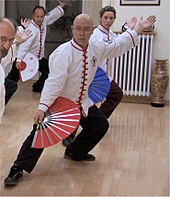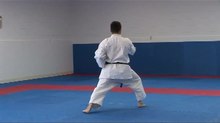Form (martial art)

A form in martial arts is a well-defined sequence of movements - such as attacks, defenses, and counter-attacks - that represent a fight against one or more real or imaginary opponents. It is an integral part of many historical martial arts forms and a form of exercise in everyday training. In today's competitive sport , the practice of the forms (form competition) plays an important role.
Designations
Shapes play a role especially in Asian martial arts and are sometimes referred to differently in German depending on their origin. Sometimes the movements of a shape are also called “images”.
| designation | Aging. | font | Aging. | language | system | Martial Art 1 | comment |
|---|---|---|---|---|---|---|---|
| Kata a | - | 形 , 型 2 | か た 2.1 | Japanese | Budo | Aikido | Form, attitude |
| Kata | - | 形 , 型 | か た | Japanese | Budo | Judo | Form, attitude |
| Kata | - | 形 , 型 | か た | Japanese | Budo | karate | Form, attitude |
| Hyeong b | Hyŏng c | 형 3 | 形 , 型 3.1 | Korean | Mudo | Taekwondo (traditional), Tang Soo Do |
Form, attitude |
| Pumsae b | P'umsae c | 품새 3 | 品 勢 3.1 | Korean | Mudo |
Taekwondo ( WTF ) |
- |
| Teul b | Tŭl c | 틀 3 | - | Korean | Mudo | Taekwondo ( ITF ) |
- |
| Taolu d | Toulou e | 套路 4 | - | Chinese | Wushu | Taijiquan | - |
| Kuen * | Kyun e | 拳 4 | - | Cantonese f | Wushu | Hung Gar Kuen | - |
| Bai-Quyen | - | Bai-Quyon 5 | - | Vietnamese | Viêt Võ Dao | Vovinam | - |
| Quyen | - | Quyền 5 | 拳 5.1 | Vietnamese | Viêt Võ Dao | Vovinam | - |
Sources: see below
- annotation
.: 套路 , Jyutping tou 3 lou 6 , Yale toulou , Cantonese tolo ;
拳 , Jyutping kyun 4 , Yale kyùhn , Cantonese kuen
people
The majority of the forms in the martial arts are single forms in which a single martial artist performs the sequence that can represent a fight with an imaginary opponent, but can also be simply a series of different movements. Individual forms are often also practiced synchronously in a group ( group synchronous form ).
There are also partner forms in which two or more people fight a - more or less realistic - fight. In individual martial arts such as jōdō , only partner forms are practiced.
Movements
Short forms involve few movements; the longest forms can contain a sequence of more than 100 movements. The speed of execution of the individual movements can differ greatly depending on the martial art and can also vary within the forms themselves. Performing a form in fast martial arts such as karate , taekwondo or Shaolin Kung Fu usually takes a few tens of seconds to a few minutes, but can take between a few tens of minutes to over an hour, for example, in slowly practiced Taijiquan .
purpose
Practicing the forms serves to teach the practitioner the various techniques of a martial art. As a rule, these are individual forms in which the practitioner fights against an imaginary opponent. This allows the practitioner to concentrate more on performing the movements correctly and is not distracted from interacting with a real partner or opponent. Shapes are often practiced together and at the same time so that a student can learn by imitating his teacher or other practitioners. Forms often form the primary school or the foundation for further learning of this martial art for the practitioner. Learning and practicing a shape takes a lot of time in order to be able to perform all movements correctly. Many masters say that learning a form takes a short time, but mastering and perfecting a form takes a lifetime.
A form can also serve to save the essence of a martial art from being forgotten and to pass it on from one generation to the next.
Shapes are also often used to demonstrate a martial art to outsiders, for example in demonstrations and shows.
Competitions
Nowadays, shapes are also used in so-called shape competitions , in which competition judges evaluate the execution of the shapes. The correctness of the execution, the dynamics, the harmony and other aspects serve as criteria. Form competitions exist in most Asian martial arts; In some martial arts such form competitions are even the only or at least the most common type of sporting competition (e.g. in Iaidō , Jōdō or in modern Wushu ).
Separate forms are often developed for competitions, but - in contrast to the traditional use of forms in martial arts - aspects such as aesthetics and choreography are in the foreground. In some cases, the forms are also accompanied by music or practiced as a synchronous form (e.g. in Taekwondo ).
literature
- Wolfgang Weinmann: The martial arts lexicon from Aikido to Zen , Verlag Weinmann, Berlin, 2000, ISBN 3-87892-044-X , p. 166
Kata: shoulder, form, ceremony - techniques or movements carried out according to a fixed scheme - fight against imaginary opponents
Web links
- Hapkido forms
- Taekwondo - The forms in the martial arts - Tul, Hyong, Kuen, Kata (PDF file 52kB)
- Taekwondo - The forms and their historical background (PDF file 492kB)
Individual evidence
- ↑ The forms in the martial arts - Tul, Hyong, Kuen, Kata. ( PDF file 52kB) In: www.taekwon-do.ch. Retrieved May 10, 2019 .
- ↑ The term kata - 形. In: tangorin.com. Retrieved May 10, 2019 (English, Japanese).
- ↑ The term kata - 形. In: Wadoku . Retrieved May 10, 2019 (German, Japanese).
- ↑ The term kata - 型. In: tangorin.com. Retrieved May 10, 2019 (English, Japanese).
- ↑ The term kata - 型. In: Wadoku . Retrieved May 10, 2019 .
- ↑ term Taolu -套路. In: www.zdic.net. Retrieved May 10, 2019 (Chinese, English).
- ↑ term Taolu -套路. In: Xinhua Zidian . Retrieved November 4, 2019 (Chinese).




